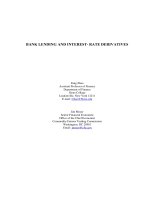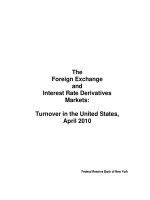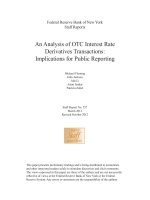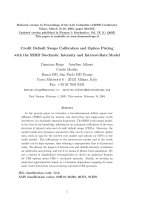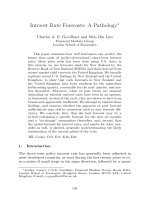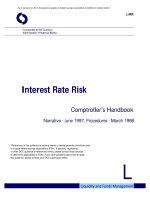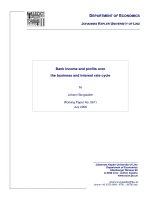Accounting for investments, fixed income securities and interest rate derivatives a practitioners handbook (volume 2), 2 edit
Bạn đang xem bản rút gọn của tài liệu. Xem và tải ngay bản đầy đủ của tài liệu tại đây (38.17 MB, 806 trang )
Contents
Foreword
Introduction
Preface
Acknowledgments
Chapter 1: Fixed Income Securities—Theory
Learning Objectives
Fixed Income Securities in General
Basics of the Bond Market
Definition of Financial Instruments
Categories of Financial Instruments—An Overview
Questions
Chapter 2: Fixed Income Securities—Fair Value through Profit or
Loss
Learning Objectives
Meaning and Definition of Fixed Income Securities
Classification of Debt Securities as “Fair Value through Profit or
Loss”
Accounting for Fixed Income Securities
Trade Life Cycle for Fixed Income Securities—Fair Value
through Profit or Loss
Corporate Action
Additional Events in the Trade Life Cycle
Complete Solution to the Illustration
FX Revaluation and FX Translation Process
Distinction between Capital Gain and Currency Gain
Illustration 1: Investment in Bonds held for Trading Purposes
Solution to Illustration 1: Investment in Bonds held for Trading
Purposes
Problem 1: Investment in Bonds (Trading) in Foreign Currency
(AUD)
Accounting Entries in Functional Currency
Summary
Questions
Chapter 3: Fixed Income Securities—Available-for-Sale
Learning Objectives
Basic Understanding of Available-for-Sale (AFS)
Accounting for Fixed Income Securities Classified as Availablefor-Sale
Option to Designate a Financial Asset at Fair Value through
Profit or Loss
Accounting for Fixed Income Securities
Trade Life Cycle for Fixed Income Securities—Available-forSale
FX Translation on Available-for-Sale Securities
Impairment of Available-for-Sale Fixed Income Securities
Bonds Classified as Available-for-Sale—Complete Solution to
the Illustration
Problem 1—Bonds Held as Available-for-Sale in USD
FX Revaluation and FX Translation process
Accounting Entries in Functional Currency—USD
Summary
Questions
Chapter 4: Fixed Income Securities—Held-to-Maturity
Learning Objectives
Meaning of Securities Classified as Held-to-Maturity (HTM)
Exceptions to the Rule for Classification as Held-to-Maturity
Effective Interest Rate
Accounting for Securities Classified as Held-to-Maturity
Trade Life Cycle for Fixed Income Securities—Held-to-Maturity
Illustration of Bonds Held-to-Maturity—Complete Solution
Problem—2: Bonds Held as Held-to-Maturity in BRL (Foreign
Currency)
Solution to Problem—2: Bonds Held as Held-to-Maturity in BRL
(Foreign Currency)
Accounting Entries in Functional Currency—Problem 2—USD
Summary
Questions
Chapter 5: Presentation, Disclosures & Reclassification
Learning Objectives
Relevant Accounting Standards
General Disclosure as per IFRS 7
A. Significance of Financial Instruments for Financial Position
and Performance
Statement of Comprehensive Income
Other Disclosures
B. Qualitative Disclosures
C. Quantitative Disclosures
Amendments to IAS 39 & IFRS 7 (October 2008)
Reclassification as per IFRS 9
Presentation of Financial Instruments
Summary
Exercise
Chapter 6: Interest Rate Derivatives—Theory
Learning Objectives
Derivatives in a Financial Instrument
Definition of Derivatives as per Accounting Standards
Accounting Standards for Interest Rate Derivatives
Differences between US GAAP and IFRS
Over-the-Counter Contracts
Exchange-Traded Derivative Contracts
Benefits of Interest Rate Derivatives
International Swaps and Derivatives Association (ISDA)
Types of Interest Rate Derivatives
Hedged or Hedging Instrument—Status of Various Financial
Instruments
Summary
Exercise
Chapter 7: Interest Rate Swaps—Receive Fixed Pay Floating
Learning Objectives
Meaning of Interest Rate Swap
Definition of a Derivative
Accounting for Interest Rate Swaps
The Trade Life Cycle for Interest Rate Swaps
Receive Fixed & Pay Floating—Illustration 1
Complete Solution to Illustration 1: Interest Rate Swap—Receive
Fixed Pay Floating
Problem1: Interest Rate Swap—Receive Fixed Pay Floating
Solution to Problem 1: Interest Rate Swap—Receive Fixed Pay
Floating
Summary
Questions
Chapter 8: Interest Rate Swaps—Pay Fixed Receive Floating
Learning Objectives
Meaning of Receive Floating and Pay Fixed Type of Interest Rate
Swap
Accounting Standards
The Trade Life Cycle for Interest Rate Swaps
Pay Fixed and Receive Floating—Illustration 1
Complete Solution to Illustration 1: Interest Rate Swap—Receive
Floating Pay Fixed
Pay Fixed to Receive Floating—USD
Solution
Summary
Questions
Chapter 9: Interest Rate Caps
Learning Objectives
Interest Rate Caps—Description of the Product
Accounting for interest rate caps
The Trade Life Cycle for Interest Rate Caps
Interest Rate Cap Instrument—An Illustration
Complete Solution to the Illustration—Interest Rate Cap
Problem 1: Interest Rate Cap—Pay
Solution to Problem 1: Interest Rate Cap—Pay
Problem 2: Interest Rate Cap—Pay
Solution to Problem 2: Interest Rate Cap—Pay
Accounting Entries in Functional Currency
Problem 3: Interest Rate Cap—Receive
Solution to Problem 3: Interest Rate Cap—Receive
Problem 4: Interest Rate Cap—Receive
Solution to Problem 4: Interest Rate Cap—Receive
Problem 5: Interest Rate Cap—Receive
Solution to Problem 5: Interest Rate Cap—Receive
Accounting Entries in Functional Currency
Summary
Questions
Chapter 10: Interest Rate Floors
Learning Objectives
Interest Rate Floors—Description of the Product
Accounting for Interest Rate Floors
The Trade Life Cycle for Interest Rate Floors
Interest Rate Floor Instrument—An Illustration
Complete Solution to Illustration
Problem 1: Interest Rate Floor—Sale of Floor Instrument
Solution to Problem 1: Interest Rate Floor
Problem 2: Interest Rate Floor
Solution to Problem 2: Interest Rate Floor
Journal Entries in Functional Currency Problem 2: Interest Rate
Floor
Illustration: IRD Floor—Receive
Comprehensive Solution to Illustration
Problem 1: Interest Rate Floor (Receive)
Solution to Problem 1: Interest Rate Floor (Receive)
Problem 2: Interest Rate Floor (Receive)
Solution to Problem 2: Interest Rate Floor (Receive)
Accounting Entries in Functional Currency Problem 2: Interest
Rate Floor (Receive)
Summary
Questions
Chapter 11: Interest Rate Collar
Learning Objectives
Meaning of Interest Rate Collar
Collar or Reverse Collar as a Hedging Instrument
Accounting for Interest Rate Collar
The Trade Life Cycle for an Interest Rate Collar
Interest Rate Collar Instrument—An Illustration
Complete Solution to the Illustration—Interest Rate Collar
Problem 1: Interest Rate Collar
Solution to Problem 1
Entries in Functional Currency
Meaning of Interest Rate Reverse Collar
Accounting for Interest Rate Reverse Collar
The Trade Life Cycle for Interest Rate Reverse Collar
Problem 1: Reverse Collar
Solution to Problem 1: Reverse Collar
Problem 2: Reverse Collar
Solution to Problem 2: Reverse Collar
Entries in Functional Currency
Summary
Questions
Chapter 12: Cross-Currency Swaps (XCCY Swaps)
Learning Objectives
A Meaning of Cross-Currency Swaps (XCCY Swaps)
Accounting for Cross-Currency Swaps
The Trade Life Cycle for Cross-Currency Swaps
Complete Solution to Illustration 1: Cross Currency Interest Rate
Swap—USD/GBP
Accounting Entries in Functional Currency
Problem 1: Cross Currency Interest Rate Swap—USD/EUR
Accounting Entries in Functional Currency
Summary
Questions
Bibliography
Index
Copyright © 2011 John Wiley & Sons (Asia) Pte. Ltd.
Published in 2011 by John Wiley & Sons (Asia) Pte. Ltd.
1 Fusionopolis Walk, #07–01, Solaris South Tower, Singapore 138628
All rights reserved.
No part of this publication may be reproduced, stored in a retrieval system, or transmitted in any form
or by any means, electronic, mechanical, photocopying, recording, scanning, or otherwise, except as
expressly permitted by law, without either the prior written permission of the Publisher, or
authorization through payment of the appropriate photocopy fee to the Copyright Clearance Center.
Requests for permission should be addressed to the Publisher, John Wiley & Sons (Asia) Pte. Ltd., 1
Fusionopolis Walk, #07–01, Solaris South Tower, Singapore 138628, tel: 65–6643–8000, fax: 65–
6643–8008, e-mail:
This publication is designed to provide accurate and authoritative information in regard to the subject
matter covered. It is sold with the understanding that the publisher is not engaged in rendering
professional services. If professional advice or other expert assistance is required, the services of a
competent professional person should be sought.
Neither the authors nor the publisher are liable for any actions prompted or caused by the information
presented in this book. Any views expressed herein are those of the authors and do not represent the
views of the organizations they work for.
Other Wiley Editorial Offices
John Wiley & Sons, 111 River Street, Hoboken, NJ 07030, USA
John Wiley & Sons, The Atrium, Southern Gate, Chichester, West Sussex, P019 8SQ, United
Kingdom
John Wiley & Sons (Canada) Ltd., 5353 Dundas Street West, Suite 400, Toronto, Ontario, M9B 6HB,
Canada
John Wiley & Sons Australia Ltd., 42 McDougall Street, Milton, Queensland 4064, Australia
Wiley-VCH, Boschstrasse 12, D-69469 Weinheim, Germany
Library of Congress Cataloging-in-Publication Data
ISBN 978–0–470–82591–4 (Hardback)
ISBN 978–0–470–82904–2 (ePDF)
ISBN 978–0–470–82903–5 (Mobi)
ISBN 978–0–470–82905–9 (ePub)
This book is dedicated to my parents, my wife and my daughter
Foreword
This is the second volume in the series of books on the subject “Accounting for Investments” authored
by R. Venkata Subramani. This volume deals with the financial instruments in the nature of fixed
income securities and interest rate derivatives such as interest rate swaps, caps, floors, collars,
reverse collars and cross currency swaps. The comprehensiveness of the coverage is apparent from
the fact that the author has meticulously dealt with the accounting treatment, presentation and
disclosure aspects related to the fixed income securities and interest rate derivatives by any entity
dealing with such financial instruments.
Subramani is an expert in the finance field with hands on experience in the treatment of various
financial instruments for about two decades. He is also a techno-savvy professional and therefore
quite conversant with the manner in which the transactions are executed in the globalised scenario.
Being a Chartered Accountant who has passion to comprehend and apply Accounting Standards, he
has analysed the accounting aspects in the context of the US GAAP and IFRS. Wherever considered
appropriate, he has indicated the similarities and differences between the US GAAP and IFRS.
The methodical way in which the subject matter is covered with appropriate illustrations indicating
the relevant entries to be passed referring to each step in the respective transactions is bound to guide
and enlighten the readers practically. The lucid style adopted in authoring this book is sure to
communicate the nuances and intricacies with absolute clarity. The book has systematically captured
all the workings to the smallest detail as to how figures have been arrived at in each example given.
The special feature of this book is that for every category of fixed income securities, the author has
taken care to reflect the accounting entries to be passed at various stages in the entire trade life cycle
of such instruments.
The significance of the financial instruments in the corporate world cannot be undermined. Equally
important is the proper accounting, presenting and disclosing the transactions related to the financial
instruments. In the present day scenario, transparency, accuracy and accountability are perceived by
the stakeholders to be of paramount importance. This book will go a long way in facilitating proper
accounting and reporting of financial instrument related transactions same as the Volume 1 of the
same series. This Volume 2 would be a meaningful addition to the library of all the corporates,
accountants, academicians and students of finance for ready reference and guidance on the contents.
T.N. Manoharan
Padmashri awardee
Former President, The Institute of Chartered Accountants of India
Chennai
March 2011
Introduction
The last decade has been one of constant changes in theory and practice in the economic sphere. The
decade has also been one where significant changes in the thinking and organization of control
structure in the financial sector have taken place, where regulatory functions hitherto exercised by the
State have been gradually but certainly passed on to statutory supervisory bodies which have been
established as independent operators. All these have brought about exciting times with new and fresh
research in the financial sector leading to the adoption of new structures and products. It is the
financial sector that has, in the recent years, shown phenomenal growth. This has led to very
important changes in the thinking and adoption of practices in the commercial world.
Changes in accounting theory and practices have not been ignored by these developments.
Globalization which has led to a breakdown in the geographical barriers has led to a free movement
of resources, capital, manpower and ideas. Such measures have brought about a serious relook at
aligning the accounting theory and practices to global prescriptions and practices, though there are
still some areas of discussion pending even amongst the western experts on principles.
The unprecedented growth in the financial sector has called for not only an adoption of changed
accounting standards and principles but also has brought about the creation and adoption of financial
instruments that are continuously appraised and fine-tuned based on experiences of the accounting
fraternity and also other users of these instruments. Such measures attempt to bring about accounting
models that are reflective of the present day demands by plugging inherent gaps and inconsistencies in
the current complex economic environment. We are still in a formative and experimental stage and
one does not know for certain that what we adopt now will really stand the test of time and prove to
be adequate to meet the exacting demands of the future. We are still based on the hope that future
changes may not vitally affect our current practices.
It is in this background that one should view the efforts of R. Venkata Subramani in bringing out
literature on the new areas that get highlighted because of a change in the perspectives. I am informed
that the author would be bringing out a set of four volumes—all connected with the various types of
financial products that are currently available. It is encouraging to note that this professional
accountant has decided to share his scholarship and expertise with others by authoring such
illuminating and scholarly treaties. The book written in a very simple, straight and candid manner
presupposes a basic knowledge and awareness of the current practices prevalent in this field on the
part of the reader. The efforts of the author in bringing out such a cluster of books is not only welcome
but should be appreciated in a situation where such books are not that freely available.
The present book, Accounting for Investments Volume 2—Fixed Income Securities and Interest
Rate Derivatives, covers an important area on a subject that often confuses and misleads the thinking
and behavior of even tested practitioners. Subjects such as swaps, caps, floors, and collars etc.,
which are currently extensively popular, are dealt in the book in a very facile manner to impart
education to both a novice and a professional alike.
What is very significant in the treatment of the subject in the book is that each instrument has been
treated very comprehensively—its full life cycle right from its inception to its closure or redemption
has been thoroughly explained and treated in a very simple, straight and lucid manner. Accounting
entries that are called for at each of the stages have been fully recorded and explained in the book that
makes it of great value and importance. The treatise also covers the requirements of presentation and
disclosure.
I find that the author’s approach to the subject and its treatment in the book is very practical. His
efforts are to be lauded. This work satisfies the requirements of the modern accounting theory and
practices that are assuming importance.
I have no doubt that the book will be one that will be welcomed by the experts in the field of
finance and will also be ideally satisfying the needs of the academic and the profession. The author
deserves our appreciation for his intellectual ability, clarity of thought, facile expression and above
all simplicity that pervades the entire work. I along with all others will await the release and
publication of the other two books on connected subjects to the present one to make the literature
comprehensive and complete.
My sincere appreciation is to the author for a job well done.
N. Rangachary
Retired Chairman
Central Board of Direct Taxes, New Delhi,
Government of India
Insurance Regulatory and Development Authority, Hyderabad
Preface
Accounting for Investments—Fixed Income Securities and Interest Rate Derivatives is the second
volume of the Accounting for Investments series. This volume covers the financial instruments of
fixed income securities and interest rate derivatives viz. interest rate swaps, caps, floors, collars,
reverse collars and cross-currency swaps. As in the first volume, this book provides an exhaustive
treatment of accounting, presentation and disclosure aspects of any entity dealing with such financial
instruments.
Since the break out of a severe financial crisis, which started in 2008 and virtually crippled the
world economy, the regulatory authorities including the accounting standard setters have been on their
toes and, thanks to their tireless efforts, a substantial addition to the knowledge of accounting has
been made along with a thorough overhaul of the accounting standards relating to financial
instruments. The good news is that the seat of accounting standard setting authorities on both sides of
the Atlantic are now speaking in a singular voice despite some lag in the implementation timeline.
This means that very soon there will be a “convergence” in spirit of the world’s top two standards,
although it may take a little longer before we see a single converged standard in letter.
Never in the past have we seen such rapid succession of accounting standards issued on financial
instruments continuously being revised and fine-tuned, based on input received from the accounting
fraternity and other users of financial statements across the globe. While these measures are an
attempt to bring about a better accounting model by plugging the inherent gaps and inconsistencies in
today’s complex economic environment, no one can say for sure whether these changes would prevent
such occurrence of financial crises in the future. Nevertheless, it is a good development and this book
captures the changes that have already been announced irrespective of the actual date of
implementation, and other key proposals in the exposure draft stage are also considered at the
appropriate places.
This book assumes that the reader already has basic accounting knowledge. Those who are entirely
new to the field of accounting should refer to some basic accounting books before attempting this one.
It might be useful to have some basic orientation on accounting for investments, especially plain
derivatives on equity instruments like equity futures and equity options to understand better the
concepts given in this volume. However, it is not a must and the reader can easily grasp the essentials
as this volume is meant to be self-sufficient in dealing with basic accounting concepts in so far as it
relates to the particular financial instrument under review.
The entire trade life cycle of each financial instrument is covered in detail from the accounting
perspective. For each illustration, the accounting journal entries, general ledger accounts, trial
balances, income statements and balance sheets are presented to give a complete understanding of the
accounting treatment. Also, for all calculated numbers the details of such calculations are given. The
presentation and disclosure requirements for these financial instruments are given separately in an
exclusive chapter and are not given as part of each illustration and solution to the worked out
problems in this book.
While an overview of the trade life cycle for each financial instrument is given, the readers are
advised to refer other resources for a detailed treatment on the trade life cycle from the front office
and middle office perspective. The trade life cycle in so far as it relates to the back office viz. the
accounting aspects are covered in detail with appropriate reference to the GAAP or IFRS
requirements. For each financial instrument, the relevant accounting standards that are applicable are
given and wherever necessary a comparison showing the similarities and differences between the US
GAAP and IFRS is also provided.
CHAPTER ARRANGEMENT
Chapter 1: Fixed Income Securities—Theory—This chapter gives some basics of fixed income
securities, basics of bond markets, types of issues and special characteristics, bond coupons, bond
maturity, bond pricing, yield measures, duration and certain types of bonds like municipal bonds,
corporate bonds, risks of investment in bonds and so on.
Chapter 2: Fixed Income Securities—Fair Value through Profit or Loss —This chapter covers
the accounting for fixed income securities held for trading purposes. After explaining the meaning and
definition of fixed income securities, an overview of the categories of financial instruments is given
along with the recent changes contemplated by the accounting standard IFRS 9. The explanation of
fair value through profit or loss is given with the circumstances in which the designation at fair value
through profit or loss on initial recognition is allowed. Fair value concepts and the measurement
hierarchy of fair value as per the accounting standard are explained here.
The trade life cycle for fixed income securities held as trading securities is given with the
accounting entries to be passed at various stages. Illustrations cover fixed income securities in the
functional currency of USD held for trading purposes.
Distinctions between FX revaluation and FX translation are given in great detail along with the
explanation of functional currency, foreign currency and presentation currency and the requirements of
accounting standards in this regard. Another illustration covers bonds in AUD with the functional
currency of USD explaining the FX revaluation and FX translation processes.
Chapter 3: Fixed Income Securities—Available-for-sale —This chapter covers the accounting
for bonds that are held as available-for-sale. Amendments made through IFRS 9 that impacts this
category is explained. FX translation on available-for-sale securities calls for some special
treatment, which is explained in this chapter.
The trade life cycle for bonds classified as available-for-sale securities is given with the
accounting entries to be passed at various stages. One illustration covers equity shares in the
functional currency of USD held as available-for-sale; one more illustration is given in a foreign
currency with FX translation into the functional currency of USD.
Chapter 4: Fixed Income Securities—Held-to-Maturity—This chapter covers the accounting for
bonds that are classified as held-to-maturity. Meaning of securities classified as held-to-maturity is
discussed. Tainting rules along with exceptions are given. However, tainting rules are dispensed with
in light of the recent changes made to this category. Similar changes are also proposed by the FASB.
The concept of effective interest rates is then explained. Impairment provisions relating to amortized
cost category is covered in this chapter.
The trade life cycle for bonds classified as held-to-maturity securities is given with the accounting
entries to be passed at various stages. One illustration covers equity shares in the functional currency
of USD held as available-for-sale. FX revaluation and FX translation on held-to-maturity securities
is explained with the help of one more illustration, which is given in foreign currency with FX
translation and accounting entries in the functional currency.
Chapter 5: Presentation, Disclosure & Reclassification—This chapter covers the current
accounting standards for the presentation of financial instruments in the financial reporting system, the
mandatory disclosures required for these financial instruments, as well as the requirements when an
entity reclassifies the financial instruments. The presentation and disclosure requirements are very
important as these give quantitative and qualitative information about the financial position of the
entity and provide adequate information for the reader of the financial statements to understand the
nature and extent of risks undertaken by the entity. These presentation and disclosure requirements are
mandatory and ought to have been provided in the illustrations and solutions to problems throughout
this book. However, for the sake of convenience the requirements are all bunched and presented in
this chapter only. Readers should understand that these requirements should be taken to be an
inclusive component of the illustrations and solutions to the problems throughout the book.
Chapter 6: Interest Rate Derivatives—Theory—This chapter covers the theoretical aspects of
interest rate derivatives. First an explanation of what is meant by derivatives in a financial instrument
is explained, followed by a definition of derivatives as per US GAAP as well as IFRS accounting
standards. Then the nuances of over-the-counter derivates are elaborated on comparing the same with
exchange-traded derivative contracts. The benefits of interest rate derivatives are spelled out.
The following common types of interest rate derivatives are briefly explained viz. forward rate
agreements, interest rate swaps, caps, floors, interest rate collars, reverse collars, swaption, and
cross-currency swaps. The status of various financial instruments for hedging purposes is covered in
this chapter.
Chapter 7: Interest Rate Swaps—Receive Fixed Pay Floating—This chapter covers the
accounting aspects of interest rate swaps—receive fixed and pay floating. Meaning of interest rate
swap—receive fixed and pay floating is explained with an illustration. The definition of a derivative
as per US GAAP and as per IFRS is then given.
The trade life cycle for an interest rate swap contract is given with the accounting entries to be
passed at the various stages. The trade life cycle for an interest rate swap contract viz. recording the
trade; accounting for the upfront fee in the form of premium on the trade; resetting the interest rate on
the floating leg; accrual of interest on the pay leg as well as the receive leg on the valuation date;
accounting for the interest payable on the pay leg as well as the receive leg on the coupon date;
payment or receipt of net interest; valuation entries on valuation date; and the termination of the trade
and accounting for termination fee are all covered. Ane illustration covers the accounting aspects of
an interest rate swap contract in the functional currency of USD.
Chapter 8: Interest Rate Swaps—Pay Fixed Receive Floating—This chapter covers the
accounting aspects of interest rate swaps—pay fixed and receive floating. The meaning of an interest
rate swap—pay fixed and receive floating is explained with an illustration.
The trade life cycle for an interest rate swap contract is given with the accounting entries to be
passed at the various stages. The trade life cycle for an interest rate swap contract viz. recording the
trade; accounting for the upfront fee in the form of premium on the trade; resetting the interest rate on
the floating leg; accrual of interest on the pay leg as well as receive leg on the valuation date;
accounting for the interest payable on the pay leg as well as the receive leg on the coupon date;
payment or receipt of net interest; valuation entries on valuation date; and termination of the trade and
accounting for termination fee are all covered. An illustration covers the accounting aspects of an
interest rate swap contract in the functional currency of USD.
Chapter 9: Interest Rate Caps—This chapter covers the accounting aspects of interest rate caps.
The meaning of interest rate caps is explained with an illustration, before covering the benefits of
interest rate caps and the risk associated with it.
The trade life cycle for an interest rate cap contract is given with the accounting entries to be
passed at the various stages. The trade life cycle for an interest rate cap contract viz. recording the
trade; accounting for the upfront fee in the form of premium on the trade; receive or pay the interest on
the coupon date depending upon the actual interest rate; valuation entries on valuation date; and
termination of the trade and accounting for termination fee are all covered. An illustration gives the
accounting aspects of an interest rate cap contract in the functional currency. One problem as a holder
of the cap instrument and another problem as a writer of the cap instrument are also given here.
Chapter 10: Interest Rate Floors—This chapter covers the accounting aspects of interest rate
floors. The meaning of interest rate floors is explained with an illustration before covering the
benefits of interest rate floors and the risk associated with it.
The trade life cycle for an interest rate floor contract is given with the accounting entries to be
passed at various stages. The trade life cycle for an interest rate floor contract viz. recording the
trade; accounting for the upfront fee in the form of premium on the trade; receiving or paying the
interest on the coupon date depending upon the actual interest rate; valuation entries on valuation date;
and termination of the trade and accounting for termination fee are all covered. An illustration gives
the accounting aspects of an interest rate floors contract in the functional currency. One problem as a
holder of the floor instrument and another problem as a writer of the floor instrument are also
provided.
Chapter 11: Interest Rate Collar—This chapter covers the accounting aspects of interest rate
collars and reverse collars. The meaning of an interest rate collar is explained with an illustration,
before covering the benefits of an interest rate collar and the risk associated with it. An interest rate
collar is an instrument that gives protection against rising rates by guaranteeing that the holder will
never pay above a pre-agreed rate but at the same time sets a downside rate below the floor rate,
which the holder will benefit from if interest rates do fall below the floor rate.
The trade life cycle for an interest rate collar contract is given with the accounting entries to be
passed at the various stages. The trade life cycle for an interest rate collar contract viz. recording the
trade, accounting for the upfront fee in the form of premium on the trade, receiving or paying the
interest on the coupon date depending upon the actual interest rate, valuation entries on valuation date,
termination of the trade and accounting for termination fee are all covered. An illustration gives the
accounting aspects of an interest rate collar contract in the functional currency.
Similarly, the accounting and trade life cycle of a reverse collar are also given with suitable
illustrations.
Chapter 12: Cross-Currency Swaps—This chapter covers the accounting aspects of crosscurrency swaps—receive floating and pay floating in different currencies. Meaning of a crosscurrency swap is explained with an illustration.
The trade life cycle for a cross-currency swap contract is given with the accounting entries to be
passed at various stages. The trade life cycle for a cross-currency swap contract viz. recording the
trade, accounting for the upfront fee in the form of premium on the trade, resetting the interest rate on
the floating leg, accrual of interest on the pay leg as well as receive leg on the valuation date,
accounting for the interest payable on the pay leg as well as the receive leg on the coupon date,
payment or receipt of net interest, valuation entries on valuation date, termination of the trade and
accounting for termination fee are all covered. FX revaluation and FX translation for a crosscurrency swap contract is explained with the help of an illustration.
Acknowledgments
I would like to thank Nick Wallwork, Publisher, John Wiley & Sons (Asia) Pte. Ltd. for agreeing to
publish the second volume of this series. I would like to thank Jules Yap, Joel Balbin and the entire
production team at John Wiley. Without their persevering efforts and help this book might have never
seen the light of the day. I want to acknowledge Grace Pundyk for her wonderful copy editing of my
text.
Special thanks to Loretta Wickenden, Chief Executive Officer of Latilla LLC for her very
meticulous efforts in dotting the i’s and crossing the t’s.
I want to express my deep gratitude to respected Sri N. Rangachary, Past Chairman of the Central
Board of Direct Taxes, India and also Past Chairman of Insurance Regulatory and Development
Authority, India who is also a Chartered Accountant for writing the introduction for the second
volume. I take this opportunity to express my sincere thanks to my well wisher, respected Padmashri
T. N. Manoharan, Past President of the Institute of Chartered Accountants of India, for writing the
foreword. My sincere thanks go to all the other learned reviewers who came up with critical
comments enabling me to improve this volume of the book.
I want to particularly thank my parents, S. Ramachandran and Parimala Ramachandran, who
constantly motivated me to complete the second volume amidst my other commitments. Last but not
the least, my heartfelt gratitude goes out to my loving wife, Dr. Rama, and my affectionate daughter,
Ramya, who encouraged and motivated me constantly to pursue my goal of completing the second
volume.
R. Venkata Subramani
Chennai
CHAPTER 1
Fixed Income Securities—Theory
LEARNING OBJECTIVES
After studying this chapter you will be able to get a grasp of the following:
Fixed income securities in general
Basics of the bond market
Types of issues and special characteristics
Bond coupons
Bond maturity
Bond pricing
Yield measures—current yield, yield to maturity, and yield to call
Duration
Corporate bonds
Municipal bonds
Risks of investment in bonds
Definition of financial instruments
An overview of the categories of financial instruments
Recent amendments to accounting standards relating to financial instruments
FIXED INCOME SECURITIES IN GENERAL
Fixed income refers to any type of investment that yields a regular (or fixed) return. A bond is a debt
security. When an investor purchases a bond, the investor is actually lending money to the issuer of
the bond. The issuer could be a government, municipality, corporation, federal agency or other entity.
In return for the money lent, the issuer provides the investor with a certificate in which it promises to
pay a specified rate of interest during the life of the bond and to repay the face value of the bond (the
principal) when it matures, or comes due. This certificate is known as the “bond.”
Among the types of bonds available for investment are: U.S. government securities; municipal
bonds; corporate bonds; mortgage- and asset-backed securities; federal agency securities; and foreign
government bonds.
BASICS OF THE BOND MARKET
Types of issues and special characteristics
Various governments issue government bonds in their own currency and sovereign bonds in foreign
currencies. Local governments issue municipal bonds to finance their projects. Corporate entities also
issue bonds or borrow money from a bank or from the public.
The term “fixed income security” is also applied to an investment in a bond that generates a fixed
income on such investment. Fixed income securities can be distinguished from variable return
securities such as stocks where there is no assurance about any fixed income from such investments.
For any corporate entity to grow as a business, it must often raise money to finance the project, fund
an acquisition, buy equipment or land or invest in new product development. Investors will invest in
a corporate entity only if they have the confidence that they will be given something in return
commensurate with the risk profile of the company.
Bond coupon
The coupon or coupon rate of a bond is the amount of interest paid per year expressed as a percentage
of the face value of the bond. It is the stated interest rate that a bond issuer will pay to a bond holder.
For example, if an investor holds $100,000 nominal of a 5 percent bond then the investor will
receive $5,000 in interest each year, or the same amount in two installments of $2,500 each if interest
is payable on a half-yearly basis.
The word “coupon” indicates that bonds were historically issued as bearer certificates, and that the
possession of the certificate was conclusive proof of ownership. Also, there used to be printed on the
certificate several coupons, one for each scheduled interest payment covering a number of years. At
the due date the holder (investor) would physically detach the coupon and present it for payment of
the interest.
Bond maturity
The bond’s maturity date refers to a future date on which the issuer pays the principal to the investor.
Bond maturities usually range from one year up to 30 years or even more. But this maturity date must
be seen as the last future date (except if the borrower is in default) on which the investor will receive
the principal amount from the issuer. Depending on redemption features, the real reimbursement date
can be very different (much shorter). These redemption features usually give the right to the investors
and/or the issuer to advance the maturity date of the bond.
Call feature: This is a provision that allows the issuer to repay the bond before the maturity date.
The issuer will “call” his bond if the interest rate index is lower than when the bond was originally
issued. From the investor’s perspective, it means that the bond gets prepaid if the bond earns too
much interest compared to the prevailing market rates.
Put feature: This is a provision that gives investors the right to put the bond back to the issuer to
redeem the bond before the maturity date. An investor would exercise this option when the current
market rates are higher so that the investor can reinvest his money at this higher rate.
Bond pricing
The price of a bond will be determined by the market, taking into account among other things:
The amount and date of the redemption payment at maturity;
The amounts and dates of the coupons;
The ability of the issuer to pay interest and repay the principal at maturity;
The yield offered by other similar bonds in the market.
Yield measures
Current yield
To obtain the current yield, the annual coupon interest is divided by the market price. The current
yield calculation takes into account only the coupon interest and no other source of return that will
affect an investor’s yield. The capital gain that the investor will realize when a bond is purchased at a
discount, or the capital loss that the investor will realize if a bond purchased at a premium is held to
maturity are not taken into consideration. The time value of money is also ignored. Hence it is
considered as an incomplete and simplistic measure of yield.
Yield to maturity
The yield on any investment is the interest rate that will make the present value of the cash flows from
the investment equal to the price of the investment. As a starting point an approximate value is
calculated as being the average income per period divided by the average amount invested. To find a
more accurate value, an iterative procedure is used. The objective is to find the interest rate that will
make the present value of the cash flows equal to the price.
The yield to maturity calculation considers the current coupon income as well as the capital gain or
loss the investor will realize by holding the bond until maturity. Also it takes into account the timing
of the cash flows.
Yield to call
For bonds that may be called prior to the stated maturity date another yield measure commonly quoted
is known as the “yield to call.” To compute the yield to call, the cash flows that occur if the issue is
called on its first call date are used.
Duration
The duration of a bond is a measure of the sensitivity of the bond’s price to interest rate movements. It
broadly corresponds to the length of time before the bond is due to be repaid. This duration is equal
to the ratio of the percentage reduction in the bond’s price to the percentage increase in the
redemption yield of the bond. This equation is valid for small changes in those quantities only.
Duration is symbolized by λ, or lambda, the Greek letter used for derivative pricing. In contrast, the
absolute change in a bond’s price with respect to interest rate (Δ or delta) is referred to as the dollar
duration.
Corporate bonds
A corporate bond is a bond issued by a corporation. It is a bond that a corporation issues to raise
money in order to expand its business. The term is usually applied to longer-term debt instruments,
generally with a maturity date falling at least a year after their issue date.
Corporate bonds are often listed in major stock exchanges and they are traded in the secondary
market. However, despite being listed on exchanges, the vast majority of trading volume in corporate
bonds in most developed markets takes place in decentralized, dealer-based, over-the-counter
markets. The bond price depends on the prevailing market interest rates during the time of trading.
The bond price will go up if the mentioned coupon rate is higher than the market interest rate. During
that time the bonds are quoted at a premium. On the other hand, if the mentioned coupon rate is less
than the market interest rate, the price of the bonds will come down and they are quoted at a discount.
The coupon rate received by the bond holder is usually taxable. Corporate bonds will have a higher
risk of default when compared to government bonds.
Municipal bonds
Municipal bonds are debt obligations issued by states, cities, counties and other governmental
entities, which use the money to build schools, highways, hospitals, sewer systems, and many other
projects for the public good.
Not all municipal bonds offer income exempt from both federal and state taxes. There is an entirely
separate market of municipal issues that are taxable at the federal level but which still offer a tax
exemption on interest paid to residents of the state of issuance.
Most of this municipal bond information refers to munis, which are free of federal taxes. See the
section on Taxable Municipal Bonds for more about taxable municipal issues.
Zero coupon bonds
Zero coupon bonds are bonds that do not pay interest during the life of the bond. Instead, investors
buy zero coupon bonds at a deep discount from their face value, which is the amount a bond will be
worth when it “matures” or comes due. When a zero coupon bond matures, the investor will receive
one lump sum equal to the initial investment plus the imputed interest.
Risks of investment in bonds
Interest rate risk: When interest rates rise, bond prices fall; conversely, when interest rates decline,
bond prices rise. The longer the time to a bond’s maturity, the greater its interest rate risks.
Duration risk: The modified duration of a bond is a measure of its sensitivity to interest rate
movements, based on the average time to maturity of its interest and principal cash flows. Duration
enables investors to more easily compare bonds with different maturities and coupon rates by
creating a simple rule: with every percentage change in interest rates, the bond’s value will decline
by its modified duration, stated as a percentage. For example, an investment with a modified duration
of five years will rise 5 percent in value for every 1 percent decline in interest rates and fall 5
percent in value for every 1 percent increase in interest rates.
Reinvestment risk: When interest rates are declining, investors have to reinvest their interest
income and any return of principal, whether scheduled or unscheduled, at lower prevailing rates.
Inflation risk: Inflation causes tomorrow’s dollar to be worth less than today’s; in other words, it
